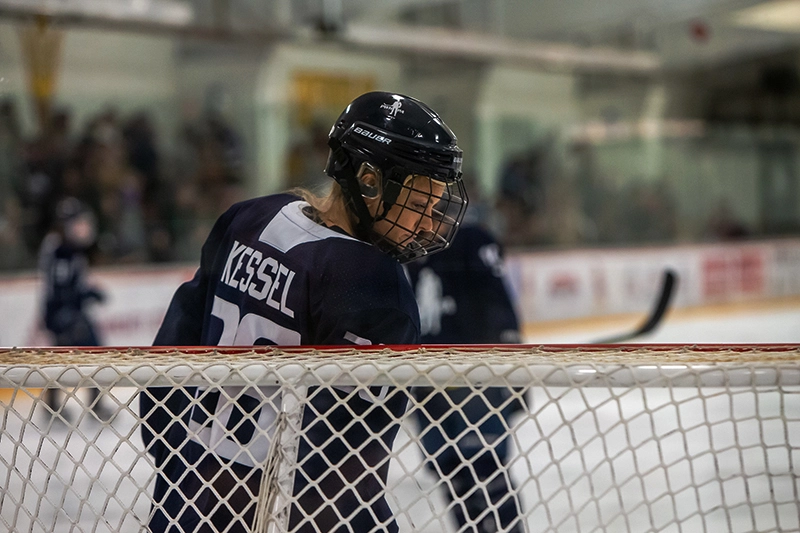You can’t wait to switch from a full cage or a fishbowl to a visor on your hockey helmet, just like your favorite NHL players. Trust me, I get the excitement. I’ve been there.
But what age do you have to be to wear a visor in hockey?
18 years old. Once you turn 18, you can switch from a full cage to a visor. Some ice hockey leagues will require you to sign a waiver before you are allowed to make the switch.
A full face shield is mandatory for every minor league player 18 and under.
Table of Contents
What about in college hockey?
In 1978 the NCAA introduced a rule making it mandatory for all players to wear a full face shield. In their words, to protect the eyes of the players.
If you are planning on playing college hockey, you will have to wear a full cage or a fishbowl no matter what age you are.
Since the rule was introduced, and most recently in 2012, the discussion of allowing college hockey players to wear three-quarter visors has been brought up a few times, failing to materialize any change to the rule each time.
This despite 83% of people out of 1000 polled college hockey players and coaches saying they would prefer to wear a visor.
Can women’s hockey players wear visors?
Any time you watch women’s hockey, no matter what level, they always appear to be wearing cages. Are women’s hockey players allowed to wear visors?
No, women’s hockey players are not allowed to wear visors. This is because all levels of women’s hockey; IIHF, NWHL, College, Olympics, mandate that they wear full face shields.
If you ask me, it’s because they are smarter than us guys, and most would rather not wear a visor to avoid facial injuries. Hockey leagues that do not require its players to use a full face shield see twice the number of facial injuries than those which do require a full face shield.
Are they really worth it?
Most people before the age of 18 can’t wait to switch to a visor from a cage, but why? Is there actually any benefits of wearing a visor that you don’t get when wearing a cage?
Whether a visor is worth it depends entirely on personal preference, here are some benefits and disadvantages that come with wearing a visor for hockey.
Benefits of wearing a visor
1) Visibility
This pretty much goes without saying, when you wear a visor it opens up your field of vision dramatically. You are no longer distracted by the bars running up and across your helmet, obstructing your peripheral vision.
2) Easier to hydrate
Sure, you can just as easily squirt your Gatorade through your full cage, but we all know if you miss and hit a bar, your drink is going everywhere. With a visor, you don’t face the same obstacle and drinking is as easy as, well, drinking.
3) Easier to clear sweat away
Is there anything more annoying than having to undo your helmet just to wipe your face down with a towel to avoid sweat getting into and burning your eyes?
Visors make it so much easier to take care of this issue without having to remove your helmet or undo a cage.
4) Lightweight
It’s not a huge difference in weight, but it’s a noticeable one.
Wearing a visor, you will immediately feel the reduced weight compared to when you wore a full cage. Allowing better neck mobility for checking over your shoulders etc.
Disadvantages of wearing a visor
1) Lack of facial protection
Fact is, all the pros that come with wearing a visor in hockey come at a cost.
That cost is facial protection. Players who wear visors are two times as likely to receive a facial injury than a player wearing a full shield.
One errant stick or shot to the face, and you could be in a world of hurt. Think about how often a stick has come up and hit you in your cage, now imagine there is no cage there to protect you.
2) Fog
It seems that no matter what you try, you can’t stop your visor from fogging up. This often leads to you having to push it up during play to see, reducing your protection further.
3) Scratches
You know what’s annoying? Playing a game with a scratch right across the middle of your visor.
Visors are prone to scratching and can quickly rack them up throughout a season.
3) Added expenses
Your visor will break and need replacing far more than if you were to wear a cage, adding to the already exorbitant prices of playing hockey. Although, if you are in a professional league, you likely don’t have to pay for your own equipment.
You might also be having to pay the price for new teeth. Which is pretty high.
What it comes down to really is whether you are willing to take the risks that come with using less facial protection to enjoy the benefits that come along with it.
Do all NHL players have to wear visors?
According to the NHL rule book:
As of the 2013-14 season, all NHL players must wear a visor. Players who had more than 25 games of experience at the time the rule was introduced are still allowed to opt out of wearing a visor.
This is why you can still see some NHL players like Joe Thornton, Ryan Reaves, Ryan Getzlaf, Milan Lucic, Zack Kassian, Zdeno Chara etc. not wearing visors.
Final thoughts
Visors on hockey helmets are a great way to improve visibility, but they are not a perfect solution. They do not offer complete protection against facial injuries.
Once you turn 18, so long as you aren’t playing college hockey, it’s entirely up to you whether you want to wear one or not.






